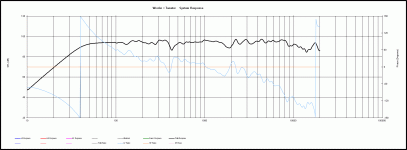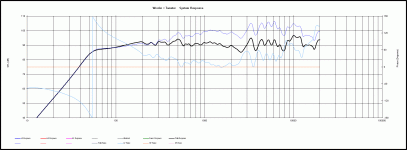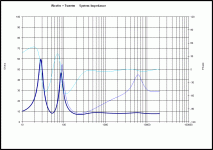I am one of the proud new owner of this "whizzer-less" full range driver and have them mounted in a variation of the BK-16 BLH cabinet. I do not have designs to provide, but they were specifically designed for this driver. Bass performance is excellent so far, and highs are filling in nicely, but I would like to implement a Zobel network to compensate for the rising impedance and I have no reliable way to measure the Le parameter accurately. Could this measurement be derived from some other method than direct measurement? Any suggestions on other methods of "taming" the peaky behavior in the 5 Khz-10 Khz range? I have only run them for 100 hours or so, so perhaps this will tame down a bit, but its enough of a distraction for me to warrant a compensation network of some kind.
For those interested in this driver, I can tell you with assurance they are an upgrade to the AN 8" Cast which I currently have as well. They offer a broader and deeper soundstage, better off-axis response, typical AN imaging, with surprisingly solid bass. Detail through the treble is every bit as good as his other offerings. Just has a very different overall presentation and I think most folks will agree that its an improvement and a step in the right direction.
For those interested in this driver, I can tell you with assurance they are an upgrade to the AN 8" Cast which I currently have as well. They offer a broader and deeper soundstage, better off-axis response, typical AN imaging, with surprisingly solid bass. Detail through the treble is every bit as good as his other offerings. Just has a very different overall presentation and I think most folks will agree that its an improvement and a step in the right direction.
Last edited:
Without measurements, calculating a zobel can be approximated using the published impedance plot and Re. Can't read the plot clearly, but its inductance rise is very low if accurate, so a zobel wouldn't accomplish enough to justify its insertion losses.
A parallel notch filter is the time honored way to deal with this driver's published break-up modes, though without measurements can be a tedious affair at best: Parallel Notch Filter Designer / Calculator Help
Parallel Notch Fliter Designer / Calculator
GM
A parallel notch filter is the time honored way to deal with this driver's published break-up modes, though without measurements can be a tedious affair at best: Parallel Notch Filter Designer / Calculator Help
Parallel Notch Fliter Designer / Calculator
GM
Since an 8" narrows in dispersion (maybe 90 degrees @ 2khz, especially without a whizzer), perhaps sitting up to 45 degrees off axis would smooth it out.
Or try a 10 band eq to see where you want to manipulate the freq response.
Either way, good to hear from someone who has tried this driver.
Norman
Or try a 10 band eq to see where you want to manipulate the freq response.
Either way, good to hear from someone who has tried this driver.
Norman
that is rather a roller coaster above 2600(?), particularly the first steep and sharp peak - dip-peak , what is that, over 8dB swing?
these would certainly not be dry and lifeless in the "presence" range
Just one other thing. I wouldn't necessarily believe those figures. The drivers improve quite a bit with break in.
For example the factory measurements of the Seas FR are a lot worse than the measurements that either Nelson or myself got.
Having said that I'm not much of a fan of the Seas driver.
For example the factory measurements of the Seas FR are a lot worse than the measurements that either Nelson or myself got.
Having said that I'm not much of a fan of the Seas driver.
See this thread:Any suggestions on other methods of "taming" the peaky behavior in the 5 Khz-10 Khz range?
http://www.audiocircle.com/index.php?topic=100689.msg1016047#msg1016047
Or this controversy:
http://www.diyaudio.com/forums/full-range/200763-how-treat-passively-peaky-fullrange-drivers.html
Aside it, here we have this browm wool blanket which I have used with sucess to tame peaky pro fullranges, no zobel or other active circuit need:
An externally hosted image should be here but it was not working when we last tested it.
Last edited:
Hi guys, I'm a little late to the party but since this doesn't really deserve a thread of its own, I'm posting it here. I've been rather interested in the "classic" driver series recently and subsequently done some work on filters. I've found the AN10 to be easier to work with than the AN8. Here's what I've got so far. This simulation incorporates full baffle step, which I modeled for a 90L bass reflex cabinet 11 1/2" wide. One element that most purists will reject is a 3-4R series resistor which helps equalize the low end and will result in better bass extension. The driver would still achieve some 95+ db efficiency after accounting for baffle step. Apart from that there are two series filters: a 2.2mH/8R BSC circuit, and a 0.5mH/1.5uF/20R LCR filter for the top end. There's lots of room to fiddle with numbers, but in the pursuit of equalizing the lower treble, some of the energy between 10-20K is lost. I think the AN10 would require a super tweeter to sound its best in this configuration. Will this rob the AN 10 classic of all its "life" and "presence?" No idea, but I hope I get to find out someday. Since the dust has barely had a chance to settle on my new 2-ways, I had better not be finding out for a year or two. 
Attachments
Same thing for the AN8 classic. This simulation is for a 40L box tuned to 50hz IIRC. The higher the actual Qts is with this woofer the more bass you'll get, of course, but I assumed the figures on the commonsense audio page to be accurate. Filters are: 2.5mH/15R BSC circuit; 0.3mH/2.2uF/20R EQ circuit. I forgot to mention that both drivers would require a zobel to tame the rising impedance with these filters. In the case of the AN8 the values are 25uF/11R. The end result is a solid 8 ohm impedance and ~92db efficiency, with bass down to about 55hz. In the graph you can also see the unfiltered response for comparison.
Edit: Added impedance profile with zobel in place. Note that the zobel has to come before the filters, not after.
Edit: Added impedance profile with zobel in place. Note that the zobel has to come before the filters, not after.
Attachments
Last edited by a moderator:
here's an inroom plot of the original stamped frame Super10 in a 70 litre reflex tuned to 41Hz
it sounded much better in a Karlsonator12 and would assume the same for the Classic - if the Classic has a bright nature.
there's no BSC on the Nirvana, the other speaker was a Behringer 2031p (passive 2-way with 8 inch woofer and 1" dome tweeter)
it sounded much better in a Karlsonator12 and would assume the same for the Classic - if the Classic has a bright nature.
there's no BSC on the Nirvana, the other speaker was a Behringer 2031p (passive 2-way with 8 inch woofer and 1" dome tweeter)
An externally hosted image should be here but it was not working when we last tested it.
- Status
- This old topic is closed. If you want to reopen this topic, contact a moderator using the "Report Post" button.
- Home
- Loudspeakers
- Full Range
- Audio Nirvana Classic



